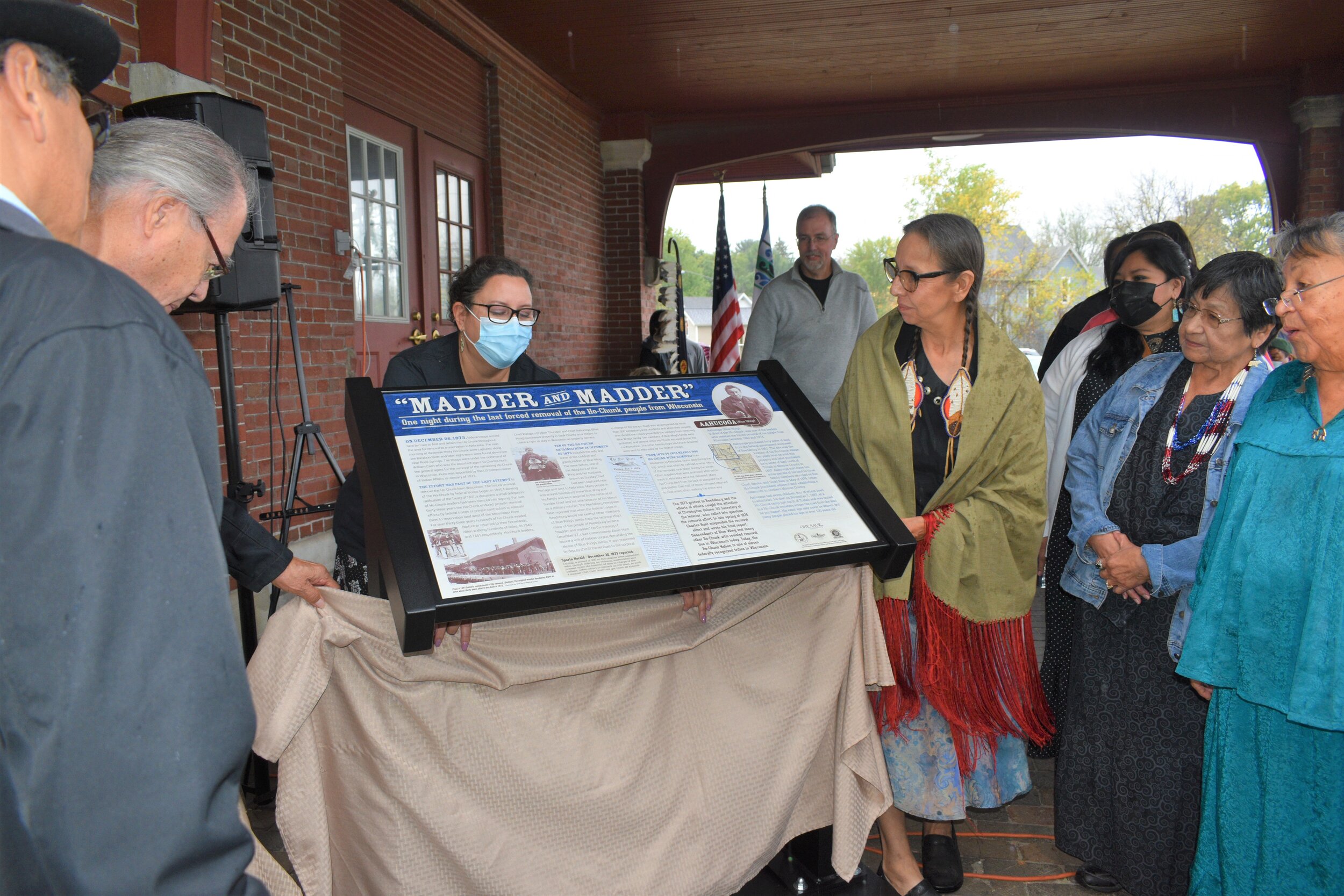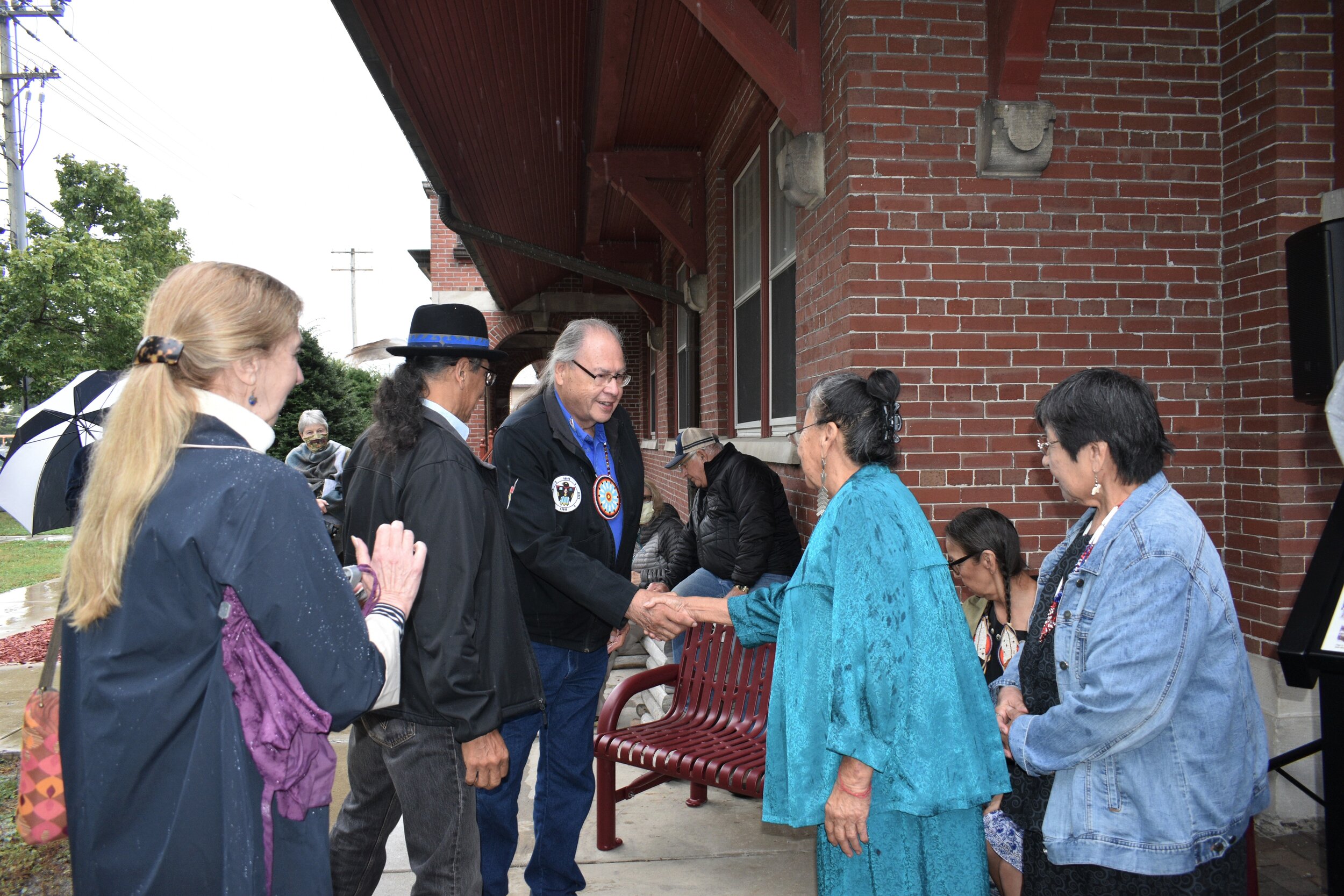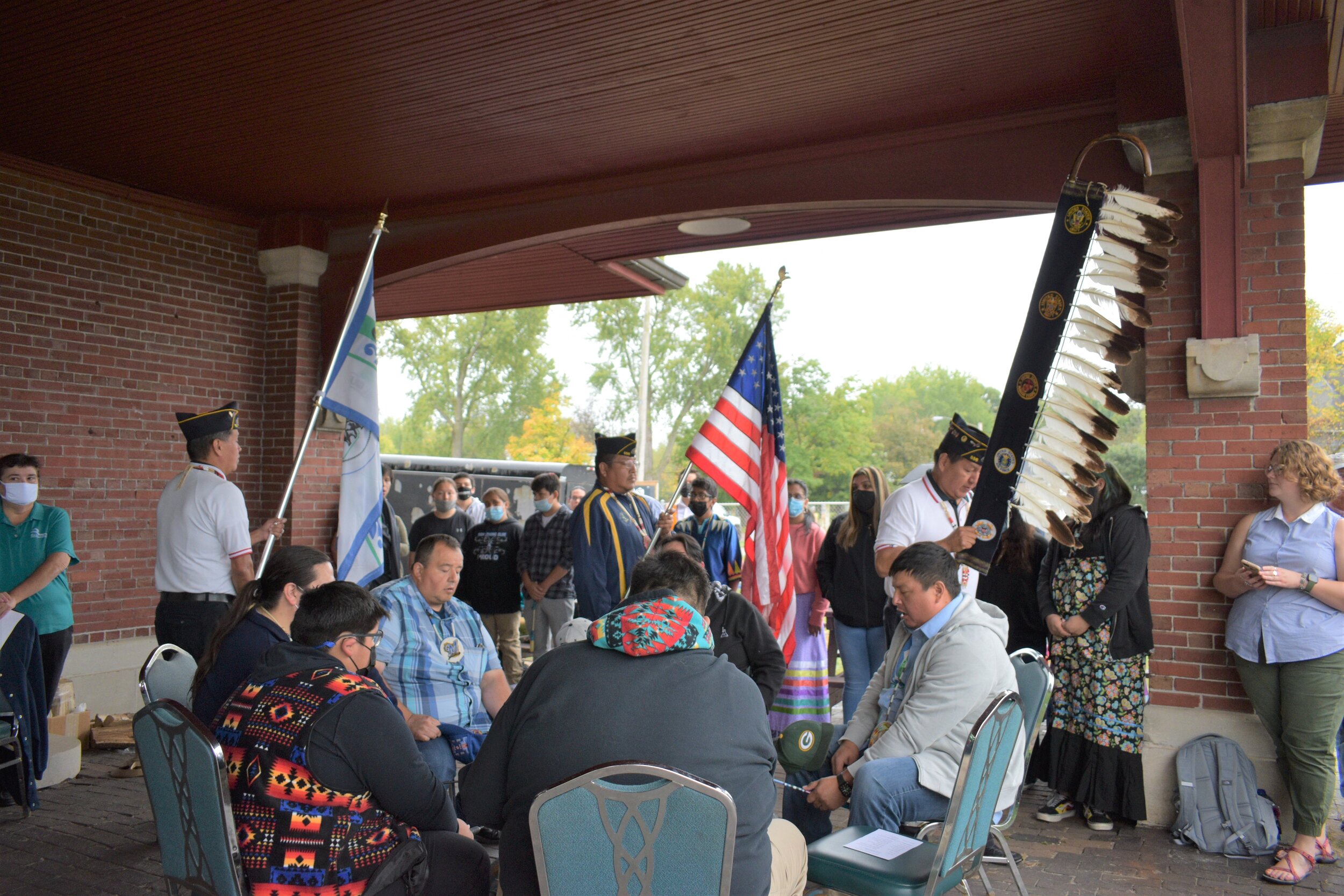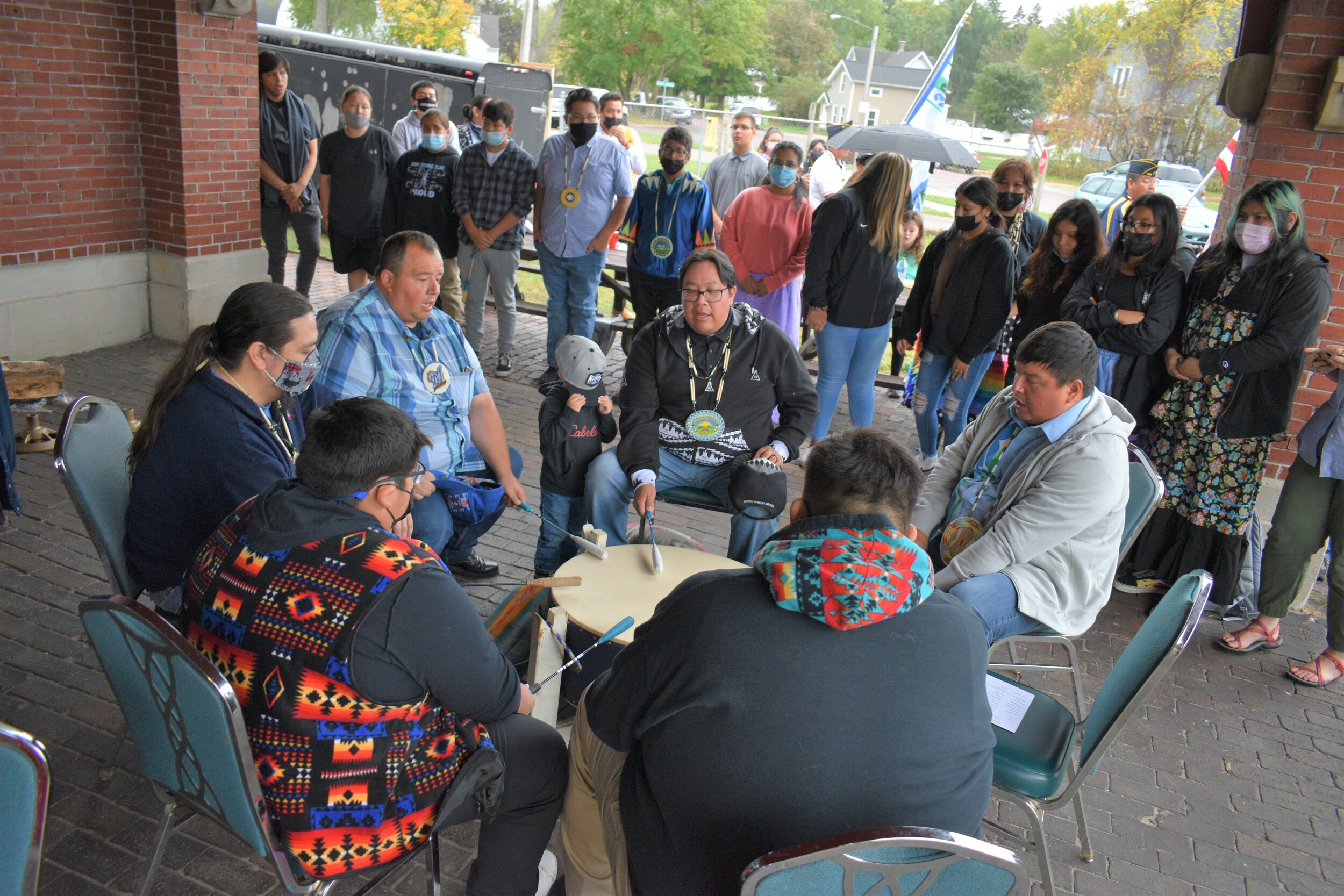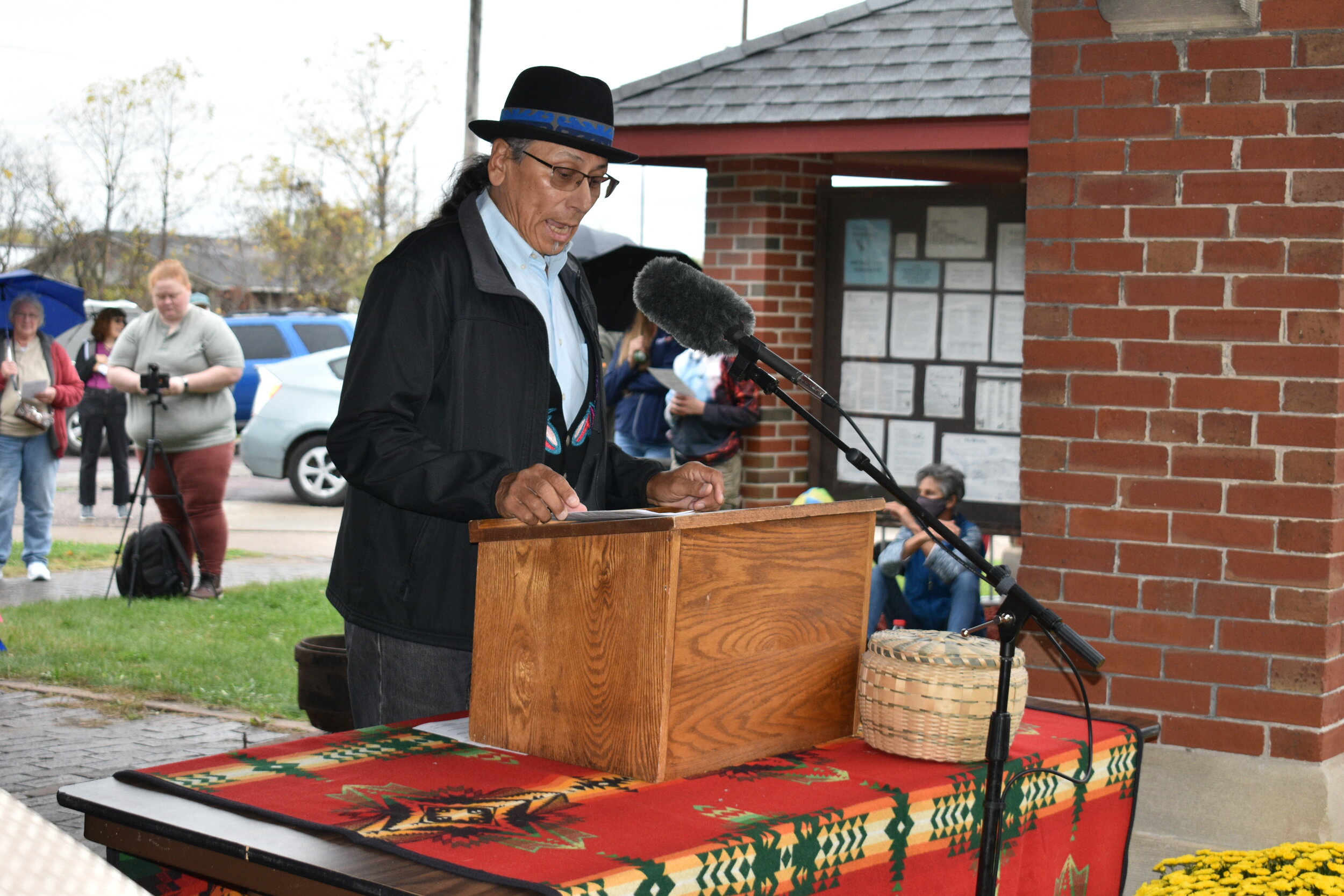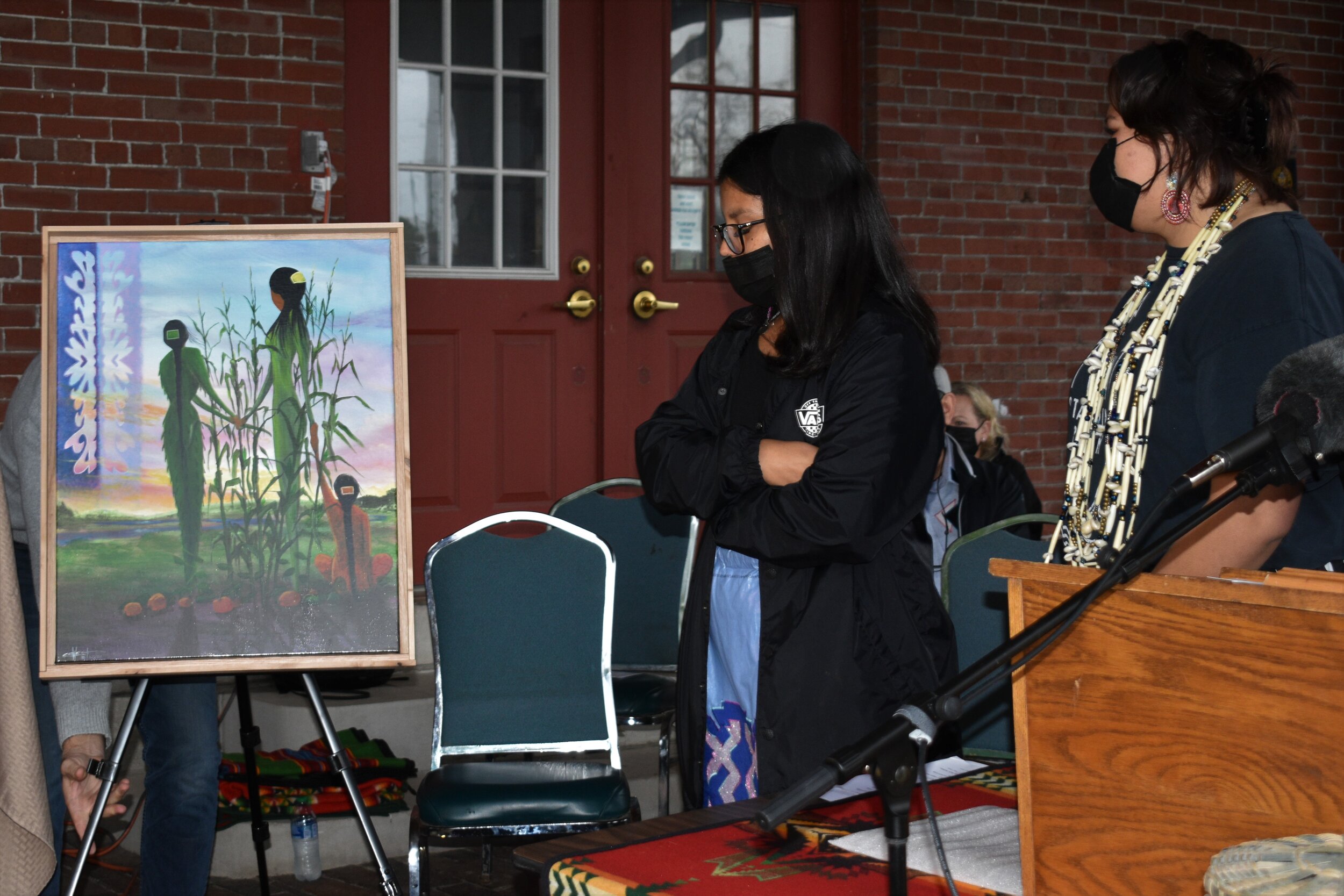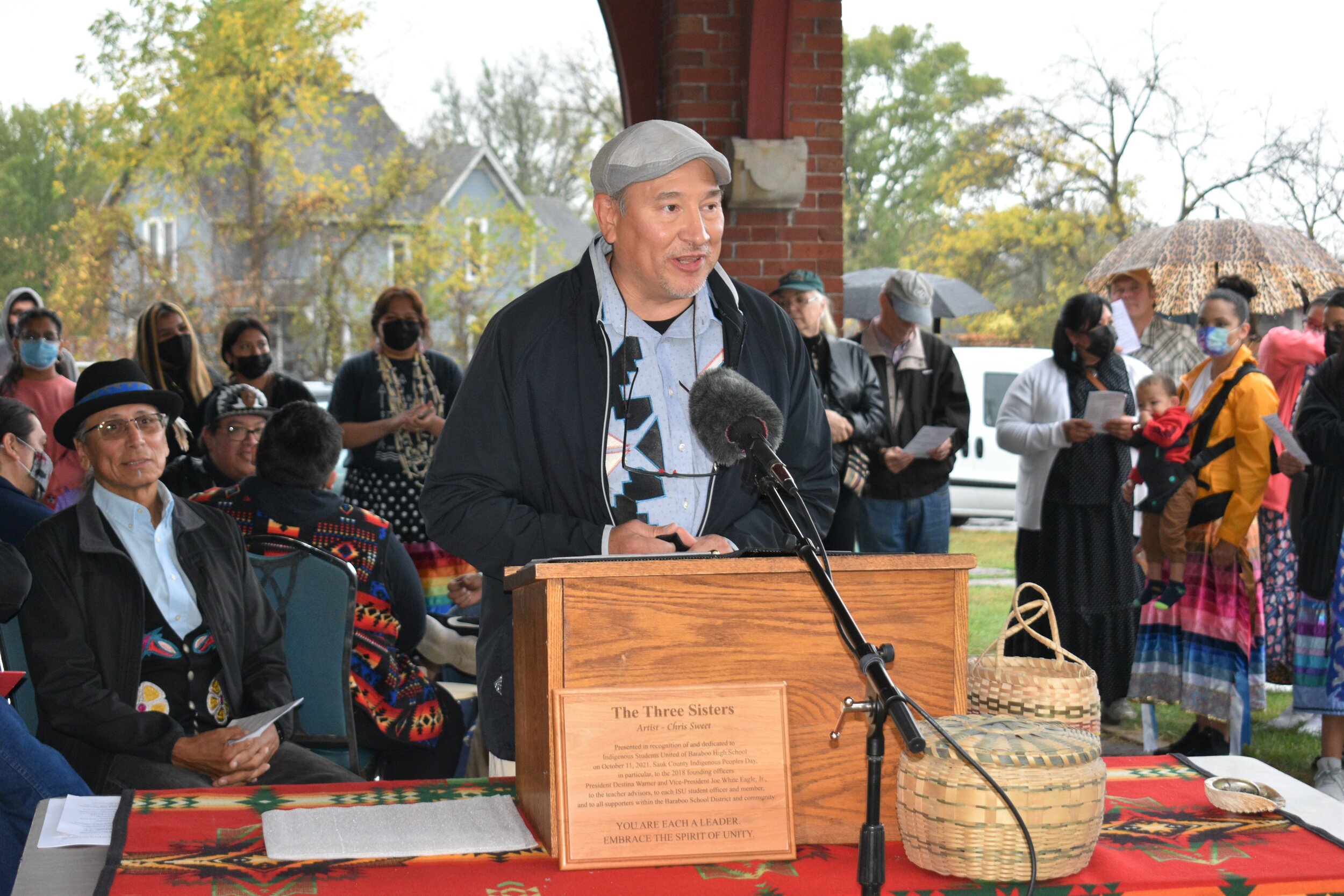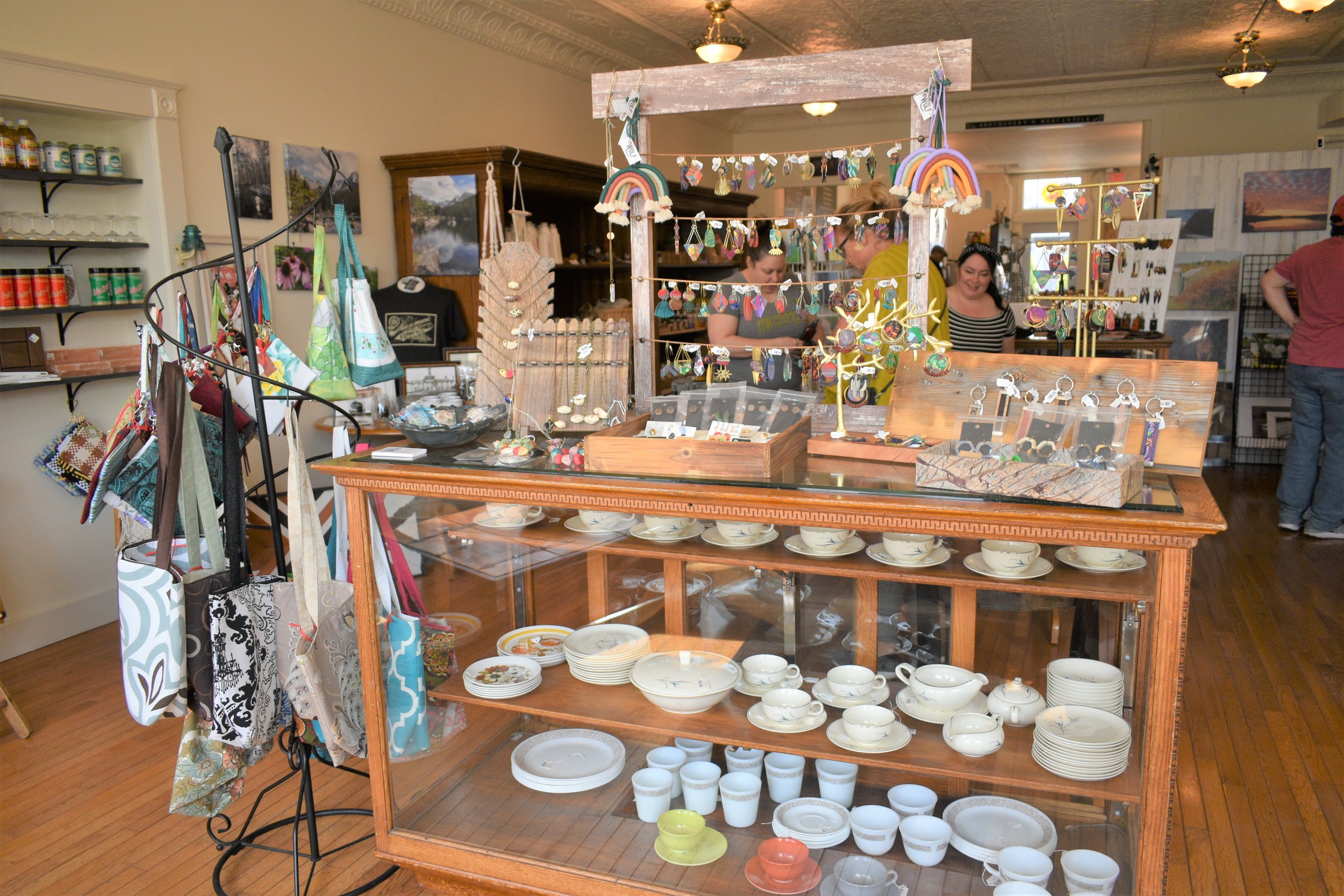City of Reedsburg commemorates 1873 event on Indigenous Peoples’ Day
This year’s Indigenous Peoples’ Day was recognized in Reedsburg, Wisconsin, and commemorated a bench, painting, and interpretive panel, acknowledging the special relationship between the people of Reedsburg and the Hoocąk (Ho-Chunk) Nation.
The commemoration focused on December 26th, 1873, when the Army attempted to remove a well-known and respected Hoocąk, Chief Aahucoga (Blue Wing), his family, and several other Hoocąk.
The events of that day unfolded in 1873 at the Reedsburg train depot that saw the people of Reedsburg rallying in protest to protect the Hoocąk, thwarting the Army’s attempt of removing them to a reservation in Nebraska.
Sauk County enacted a resolution in 2019 officially recognizing October 11th Indigenous Peoples Day. The resolution was nurtured by Sauk County Supervisor and Hoocąk Legislator Kristin White Eagle.
Dignitaries present with for the commemoration included; Reedsburg Mayor- Dave Estes, Hoocąk Nation President-Marlon White Eagle, Sauk County Supervisor and Hoocąk Legislator- Kristin White Eagle, Reedsburg Area Chamber of Commerce Executive Director- Kristine Koenecke, Sauk County Board of Supervisors Chair-Tim McCumber, Madison College Campus Manager- Linda Spencer, and Sauk County Historical Society Executive Director- Paul Wolter.
While many positive and deep meaningful words and recognitions were shared, I decided to share the words expressed by Kristine Koenecke and two descendants of Aahucoga, Master of Ceremonies- Lance Tallmadge, and Butch Artichoker.
Kristine Koenecke -
“I am happy that you can all join us today, even in the rain, and I want to thank you for coming. This is a wonderful crowd, and we're glad to have you.
In 2019, the Sauk County Board of Supervisors unanimously approved a resolution that established the second Monday of October as Indigenous Peoples’ Day. During that year, I was asked to serve as the Master of Ceremonies for that first event party which took place at the courthouse steps. For those of you who were there, you will remember that it was about 50 degrees, colder than it is today. So maybe next year we'll get sun and warm, so we'll be all working on that. But you know it's still a privilege to be there in the cold it just as it is today, to be in the rain, and I stand here with all of you on this historic site in Reedsburg. When I started working for the Chamber of Commerce, it was a surprise to me how many people visited Reedsburg from across the country. Our bike trail brings in most of the tourists, but we also have people who come to our building, just because they love old historic depots, and maybe they’re train enthusiasts.
Those of us who work here enjoy hearing their memories and stories, but we also recognize that not everyone has those same kinds of memories. The story of the attempted deportation nearly 150 years ago, is just a part of the reason that we are all here today. I think for most of us, it is more than just a significant event that is a part of Reedsburg’s past in history, because it also ultimately helped to change public policy at the federal level.
The coming together of the Reedsburg people back then to do the right thing, and the bravery and sacrifice of the Hoocąk families provides a backdrop for us today, and gives us hope for a better and more informed future. We know today that across our state and country, many groups of people just like us are standing together, and getting to know one another. Well, we should learn from the past, we always need to look forward to find better ways of doing things. And then we need to work together to get them done. These are the kinds of days when we can begin to make changes for the better. None of us were here in 1873, and so we will never know the entire story what happened in that December. We weren't alive and we didn't live through it. And sometimes the records dating back that are often a little sketchy, but that moment in time is something we can all learn from.
The Hoocąk people who were part of the event that happened here were good neighbors, faithful friends, and people who wanted to live their lives in peace. And the same is true today. The Reedsburg residents who stood up for justice were the same, and we appreciate and admire the legacy of all of those who came before us. We would likely all benefit from living our own lives as they did, which were lives of honor and dignity. We should never forget what happened here those many years ago, but we must also make the path forward, one that is worthy of the legacy of our ancestors. I know we all share those common values, and I hope that today will be remembered as a moment in time, which helped us move forward.”
Aahucoga descendant, Lance Tallmadge- “Good afternoon. It is my extreme privilege and honor to be here, to be asked to be a part of this event, this historic event. And to all my relatives out there, my elder relatives, I apologize if I misspeak here today, but I'm here, not only as a descendant of Aahucoga, but also as someone who can really shed a little light on this historic event which I hope to do so later. I also want to thank each and every one of you for attending this event, taking time out of your day to be here with us on this day that the Creator has given us. I also want to acknowledge the Winnebago Sons drum group. Thank you to my little teegas (uncles) for bringing your drum here with us and the songs that you carry. These songs tell our history. That long history of how we have survived here. Thank you for keeping these songs and our history alive.
Again, thank you for the acknowledgement of the original inhabitants of this land. It’s nice to see that recognition will be not only here in this community, but in many other communities as well.
If I might just take a moment to share some of my thoughts on this particular day and this day in history in this community. I was watching a YouTube video the other day, and one of those, I think it was one of those TED talks, it was presented by a man, Navajo man by the name of Mark Charles, and it was the title, ‘We the People’. And as we know the words ‘We the People’ are the first words to the preamble to the US Constitution. And these three words in his talk, he said, these are the three most misunderstood words. We the People. Keep in mind the era that that was written, 1700’s, it was a different mindset. We the people in the US Constitution, in his mind, did not include all the people. I don't know if you're aware of this but in the constitution, all the way through all the amendments, there was not a single reference to women, all the pronouns are he, him, his, no female reference in the Constitution. Indigenous people were referred to as savages or lesser human beings.
First, I listened to that. I thought about what happened here in this community. In 1873, there was still a mindset of native people being lesser because they were being forcibly removed from their homelands.
But yet the people of this community stepped up, came forward, and acknowledged one of their community members. They saw him as an equal, as another human being, as a valued community member. And so, it is that relationship that the people of Reedsburg had with Aahucoga and his people. They were community members, they were united. They were friends.
Aahucoga descendant, Butch Artichoker-
Hello, my name in Lakota is Praying Eagle. And my Winnebago name was given to me by Chief Winnesheik a number of years ago, and I can't pronounce it but it means thunderbolts. I want to thank the Sauk County Historical Society, the Chamber of Commerce, all the officials that are here, members of the Ho-Chunk Nation, my Hoocąk family, especially Kristin White Eagle for extending an Invitation to me. The drum is such an important thing, because we see that as the heartbeat of our Mother Earth, and the skin that covers that drum is represents the four-legged nations. And that drums like a person. The drum keeper has to take care of that.
My purpose here today is as a descendant of my grandfather, I think he was the person in high regard in this community back in the 1800s, just as he seems to remain today. My father John Artichoker was born near Tomah, and he was enrolled twice. One enrollment record stated that he was born in 1891, any other state. He was born in 1893, and his obituary used the 1893 date but he always went by the 1891 date. When he was born, his mother gave him the name, Aahucoga. My father had two grandfathers both famous, one was Aahucoga as we know, and the other one Little Priest. When my father was about six or seven years old, the government officials were readying the kids for school, and they asked him his name and he said Aahucoga, but they wrote it down as Artichoker. When I went into the military and they asked me my name I said Artichoker and at first people laughed, because it reminds them of the vegetable. He went from here, in Tomah to the boarding school, and later after a few years here, he went to Tama Iowa boarding school. And in Tama he saw the Haskell football team practicing and that really caught his interest and so he went on to Haskell. And when he completed his years of Haskell. He went on to a couple of colleges to improve his coaching skills he was a coach for a number of years. While he was in Haskell, he was what they call, I can't remember that term, but he was like a mentor to Walter Mills and Sidney Mills, and Sidney Mills was the father of Billy Mills, the Olympic gold medalist. He was invited to stay with him on a Pine Ridge Indian Reservation and that's where he met my mother, after being half absent from here, his homeland, for a long, long time. My parents after retiring, my parents build a home in Mission, South Dakota. My dad, he would walk to the post office every day. And on one occasion as he was walking behind these two young women. They were speaking in their language. He caught up to them and asked them if they would repeat themselves, and of course they did. And he said, I understand you. He hadn't heard his own language for more than 15 years. But he remembered it. And so, from that time on, even he began to come back here. And each time he would come back, and then go back to South Dakota he could see his health improved. He felt rejuvenated. He spoke quite fondly of his grandfather., even though Aahucoga died not too long after my father was born. Aahucoga an amazing man. By all accounts, some accounts say that he was over 100 years old. Another says he was 114, but his green gravestone says he was 149 years old. So I believe that one.
I am 81 and I'm looking forward to a few more years. Dr. F.D. Holbert had written that who Aahucoga was here in Sauk County when the white settlers first came, he was a chief, and apparently stood out to his own people, and was well respected by the citizens of Sauk County. He was a land owner and a taxpayer, but he was not a citizen of the United States at that time. He was noted for his integrity, his good nature. His kindness his honesty his openness, fairness and patience. These are some of the virtues that native cultures strive to live by and to teach their children. He was highly visible in this whole community. He must have had an appealing personality because the early settlers would often invite him to remain overnight with them. Upon his death, his relatives moved to the Tomah area, his family consisted of several sons and three daughters, his youngest daughter Mary. Mary Blue Wing was my father's mother and my grandmother. In a paper written by Dr. Holbert, he states that Aahucoga’s religious ideas like those of his tribe were very crude. To me, this contradicts the earlier description of a man with his high character. It's quite easy to discern that who truly lived according to his cultural traditions. I think that's an unfortunate characterization of Aahucoga’s beliefs. We often view the beliefs of others through a filter that defines our own beliefs as superior. Native people, who have interacted with the spirit world for 1000s of years, Aahucoga’s wisdom and knowledge and actions would have made him a treasure in today's world. Our cultural traditions that we have are so important now that we have 1000s of people from all over the world coming to our ceremonies to seek help and understanding each and every year, our ceremonies generally end with the directions of be good to one another, take care of each other, and love one another. It appears that Aahucoga lived by those principles and intended that in others. Those traditions were emphasized by George Cavlin and his experience with Native people that he had encountered. He said, I love people who have always made me welcome to the best they had, who are honest, without laws, who have no nails, no poorhouse, who never take the name of God in vain, who worship God without a Bible, and I believe God loves them. We're free from religious animosity, there's no criticism of other tribal beliefs. Who never raised a hand against me or stolen my property. There are many things that I would like to mention regarding our cultures, but it is this event today that requires our attention.
In 1873, as I stated today Aahucoga would have been in his late 80s or early 90s. I think I would have shed tears of appreciation for watching humanity at its best. On that day, the citizens of Sauk County and Reedsburg demonstrating, courage, compassion and love for another human being, regardless of linguistic differences, skin color or philosophical beliefs. The members of this community, demonstrating their own higher value tapping into the souls that the creator intended for all of us to preserve. A beautiful illustration of not letting the differences get in the way, and the recognition of the kindred spirit. What a tremendous example for a divided nation that we live in today. We recognize the Earth as our mother, a living being. Science has reached the point where it confirms that all things are interconnected. Land is a nurturing band, it gives strength and good health. And as I mentioned before, my father was rejuvenated and energized by returning here. Your ancestors gave a great gift by helping him to remain in his homeland. This particular location being regarded as the power of our mother. The sacred sites and places who provide that energy for that kind of healing power, and here in this land which he could continue to be spiritually nourished.
We typically end our talks with the phrase Mitakuye Oyasin. Although I'm half Ho-Chunk, this comes from the Lakota culture that I grew up, and it comes from our creation story. Before time began, there was only two things that existed. One was the black of darkness, and second, the creator that moved everywhere. The creator, being alone, wanted companionship, but could only take from itself in order to create. The Creator opened its veins, and as blood began to flow, it became creation. First to be created was the Earth along with the water. The last thing that was created was us humans. Everything that plays, crawls, walks on two legs and four legs all came before us. Everything invisible and visible came into existence, and each thing carries a responsibility with it. All things in existence came from one source, we understand that everything and everyone is our relative.
That's why address you today, Mitakuye Oyasin. You are my relative, regardless of what race or color, income, or what language you speak. I firmly believe that Aahucoga believed in that principle, and that the people of Reedsburg demonstrated that very important understanding on that day back in 1873, something that we could all learn from. I applaud the City of Reedsburg, Sauk County, Chambers of Commerce, my people, my father's people for coming together to dedicate these items here as an act of unity, an understanding that we are all one, is a beautiful legacy for our children and their children. Aho, Pinnagigi (thank you in Hoocąk), Mitakuye Oyasin.
Appreciation was extended to; Sanford White Eagle American Legion Post #556 (Joe White Eagle, Sr., Commander), Winnebago Sons, Sauk County, Ho-Chunk Nation, Madison College, Sauk County Historical Society, City of Reedsburg, Reedsburg Area Chamber of Commerce, Reedsburg ArtsLink, Hoocąk/Ojibwe artist Christopher Sweet, and the Wisconsin Department of Natural Resources.
Thank you to the cooks for the Holy food; Rita Gardner, Tina McArthur, and Ben Cleveland.
